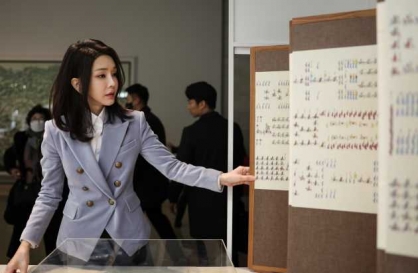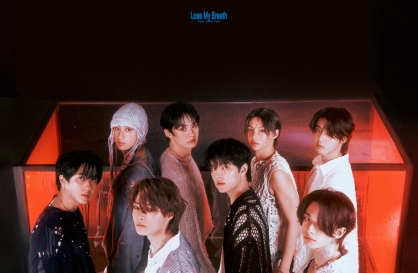Shoes with minimal soles bring maximum results for runners
By Korea HeraldPublished : June 28, 2012 - 18:53

MINNEAPOLIS ― Shelly Noland’s running shoes fit her like a glove.
Literally.
Noland is on her 14th marathon, her ninth wearing Vibram FiveFingers, minimalist shoes that cover the foot like a five-toed sock, offering protection against the occasional pebble or shard of glass, but no extra cushioning.
This is by design. There is a growing group that believes running barefoot ― or something close to it ― is best, advocating a running style that’s easier on the body.
Noland is a true believer. And, like most converts, she admits to being prone to proselytize.
“I’ve gotten some of my friends wearing them,” she said. “Or at least give them a try. And I get asked about them every place I go.”
There are those who run completely barefoot, like the members of the local chapter of the Barefoot Runners Society. Others, such as Noland, prefer the minimalist approach, using one of many makes and models with the same concept. And while it might sound counterintuitive, true believers will tell you that running this way is good for you.
It encourages a runner to run more on the naturally cushioned balls of their feet, they say, while traditional shoes ― heavily reinforced and padded ― can result in a style where the runner lands heel first. The gospel here is Christopher McDougall’s 2009 best-seller “Born to Run,” in which he got to know members of the Tarahumara Indian Tribe in Mexico, whose members are known to run very long distances at an uncommon speed.
It was while reading that book that Noland decided to change the way she ran.
Noland, 34 and a Blaine, Minnesota, resident, had reached a plateau in her running, dealing with constant knee and knee-related pain. Over a six-week period she re-learned how to run.
“Before, I was a heel-striker,” she said. “That’s why I was getting injured so much. It corrected my form. And it gave me a new appreciation for running, too. At the time I was in such a lull with running. It gave me new inspiration, something fun to try. It was a good little experiment for me.”
She isn’t alone. Running in minimalist shoes is not yet in the mainstream, but it’s growing. Sales of the FiveFingers, for instance, grew from about $450,000 in 2006 to an estimated $50 million in 2011. According to a story in the St. Louis Post-Dispatch, sales of barefoot-style shoes already has become a $1.7 billion industry.
According to Formula 4 Media, a publisher of trade magazines, that growth continues. A warm spring meant higher sales of running shoes this March compared to 2011. But the big gain was in minimalist shoes. Sales of such shoes more than doubled this March from a year ago, totaling $4 million.
For Noland, it is a night-and-day difference.
After taking time to transition to the new style, she said she has been injury free, despite training 50 or 60 miles a week. And she says she is faster. Her best marathon time in traditional shoes was about 4 hours and 19 minutes. Since the switch her best time is 3:45.
But the style might not be for everybody.
Dr. James Gladstone is the co-chair of sports medicine at Mount Sinai’s department of orthopedics in New York.
“I haven’t quite figured out who it works for and who it doesn’t,” he said. “What people have to realize is that, when they’re attempting to do it, to completely change their style of running they are changing the mechanics, too. The way the joints move, the way the foot hits the ground, how that force is distributed up into the knees and back. For some people it can be great. For others it can cause many problems.”
Running barefoot puts more pressure on the calves, the Achilles’ tendons and, in some cases, the hamstring and back.
“There is no research to show that you are less likely to get injured or that your performance will improve,” said Dr. Paul Langer, a podiatrist at Twin Cities Orthopedics and an avid runner. “But when you run barefoot, or in minimalist shoes, you do change your movement pattern. For some people that can be beneficial.”
For example, the knee might not work as hard, but the feet and ankles work harder. Langer has seen stress fractures in the feet or Achilles’ tendon injuries.
Langer, who uses minimalist shoes to augment his own training, advises people to transition into the style slowly, much like Noland did.
“I look at it as a training tool,” he said. “Some people can incorporate it into their training and it can rejuvenate their running.”
And even if minimalist shoes aren’t the end-all, the shoe industry has listened. Most manufacturers have introduced shoes that incorporate minimalist ideas.
“You’re seeing shoes, across the board, become lighter and less tricked out,” said Luke Rowe, vice president for business development for Fleet Feet, which has 95 stores throughout the country. “The minimalist discussion has been good for the overall trend in running shoes.”
For Noland, it’s more than a trend. It’s a way of life. She has been able to train harder and more often. Which is why she’s so eager to share her discovery. Still, she is in the minority. She sees a handful of like-minded folks at marathons. Her Vibrams are still a relative curiosity.
But, for her, they worked, giving her less pain and more appreciation for running.
“For me, it corrected a lot of things,” Noland said. “I haven’t been injured since. I run faster, closer to the ground. It feels more natural to me. ... They’re not for everybody. But, for me, they’ve been successful. Now, when I put traditional shoes on, they feel like cement blocks.”
By Kent Youngblood
(Star Tribune (Minneapolis))
(MCT Information Services)
Literally.
Noland is on her 14th marathon, her ninth wearing Vibram FiveFingers, minimalist shoes that cover the foot like a five-toed sock, offering protection against the occasional pebble or shard of glass, but no extra cushioning.
This is by design. There is a growing group that believes running barefoot ― or something close to it ― is best, advocating a running style that’s easier on the body.
Noland is a true believer. And, like most converts, she admits to being prone to proselytize.
“I’ve gotten some of my friends wearing them,” she said. “Or at least give them a try. And I get asked about them every place I go.”
There are those who run completely barefoot, like the members of the local chapter of the Barefoot Runners Society. Others, such as Noland, prefer the minimalist approach, using one of many makes and models with the same concept. And while it might sound counterintuitive, true believers will tell you that running this way is good for you.
It encourages a runner to run more on the naturally cushioned balls of their feet, they say, while traditional shoes ― heavily reinforced and padded ― can result in a style where the runner lands heel first. The gospel here is Christopher McDougall’s 2009 best-seller “Born to Run,” in which he got to know members of the Tarahumara Indian Tribe in Mexico, whose members are known to run very long distances at an uncommon speed.
It was while reading that book that Noland decided to change the way she ran.
Noland, 34 and a Blaine, Minnesota, resident, had reached a plateau in her running, dealing with constant knee and knee-related pain. Over a six-week period she re-learned how to run.
“Before, I was a heel-striker,” she said. “That’s why I was getting injured so much. It corrected my form. And it gave me a new appreciation for running, too. At the time I was in such a lull with running. It gave me new inspiration, something fun to try. It was a good little experiment for me.”
She isn’t alone. Running in minimalist shoes is not yet in the mainstream, but it’s growing. Sales of the FiveFingers, for instance, grew from about $450,000 in 2006 to an estimated $50 million in 2011. According to a story in the St. Louis Post-Dispatch, sales of barefoot-style shoes already has become a $1.7 billion industry.
According to Formula 4 Media, a publisher of trade magazines, that growth continues. A warm spring meant higher sales of running shoes this March compared to 2011. But the big gain was in minimalist shoes. Sales of such shoes more than doubled this March from a year ago, totaling $4 million.
For Noland, it is a night-and-day difference.
After taking time to transition to the new style, she said she has been injury free, despite training 50 or 60 miles a week. And she says she is faster. Her best marathon time in traditional shoes was about 4 hours and 19 minutes. Since the switch her best time is 3:45.
But the style might not be for everybody.
Dr. James Gladstone is the co-chair of sports medicine at Mount Sinai’s department of orthopedics in New York.
“I haven’t quite figured out who it works for and who it doesn’t,” he said. “What people have to realize is that, when they’re attempting to do it, to completely change their style of running they are changing the mechanics, too. The way the joints move, the way the foot hits the ground, how that force is distributed up into the knees and back. For some people it can be great. For others it can cause many problems.”
Running barefoot puts more pressure on the calves, the Achilles’ tendons and, in some cases, the hamstring and back.
“There is no research to show that you are less likely to get injured or that your performance will improve,” said Dr. Paul Langer, a podiatrist at Twin Cities Orthopedics and an avid runner. “But when you run barefoot, or in minimalist shoes, you do change your movement pattern. For some people that can be beneficial.”
For example, the knee might not work as hard, but the feet and ankles work harder. Langer has seen stress fractures in the feet or Achilles’ tendon injuries.
Langer, who uses minimalist shoes to augment his own training, advises people to transition into the style slowly, much like Noland did.
“I look at it as a training tool,” he said. “Some people can incorporate it into their training and it can rejuvenate their running.”
And even if minimalist shoes aren’t the end-all, the shoe industry has listened. Most manufacturers have introduced shoes that incorporate minimalist ideas.
“You’re seeing shoes, across the board, become lighter and less tricked out,” said Luke Rowe, vice president for business development for Fleet Feet, which has 95 stores throughout the country. “The minimalist discussion has been good for the overall trend in running shoes.”
For Noland, it’s more than a trend. It’s a way of life. She has been able to train harder and more often. Which is why she’s so eager to share her discovery. Still, she is in the minority. She sees a handful of like-minded folks at marathons. Her Vibrams are still a relative curiosity.
But, for her, they worked, giving her less pain and more appreciation for running.
“For me, it corrected a lot of things,” Noland said. “I haven’t been injured since. I run faster, closer to the ground. It feels more natural to me. ... They’re not for everybody. But, for me, they’ve been successful. Now, when I put traditional shoes on, they feel like cement blocks.”
By Kent Youngblood
(Star Tribune (Minneapolis))
(MCT Information Services)
-
Articles by Korea Herald





![[K-pop’s dilemma] Can K-pop break free from ‘fandom’ model?](http://res.heraldm.com/phpwas/restmb_idxmake.php?idx=644&simg=/content/image/2024/05/09/20240509050541_0.jpg&u=20240509173751)




![[News Analysis] Yoon's first 2 years marked by intense confrontations, lack of leadership](http://res.heraldm.com/phpwas/restmb_idxmake.php?idx=644&simg=/content/image/2024/05/09/20240509050612_0.jpg&u=20240509233252)








![[Today’s K-pop] NCT’s Mark to drop 1st solo album in February 2025](http://res.heraldm.com/phpwas/restmb_idxmake.php?idx=642&simg=/content/image/2024/05/10/20240510050597_0.jpg&u=)